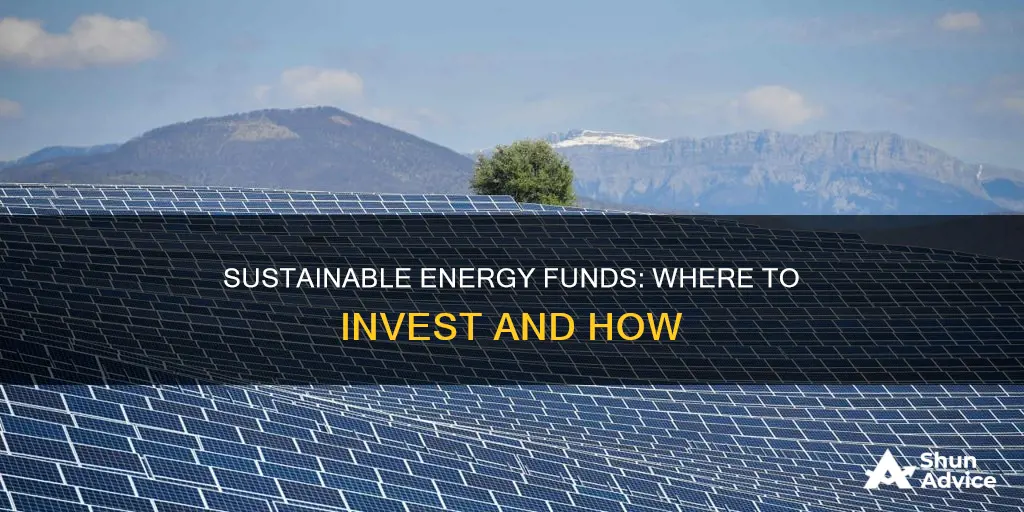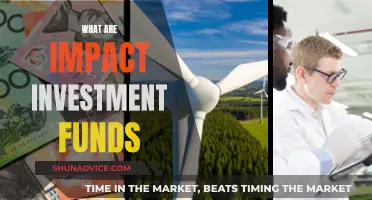
Sustainable energy funds are an increasingly popular investment vehicle, with more and more people looking to put their money into green energy solutions. The fight against climate change is a key driver for this, with many nations seeking to reach net-zero carbon emissions by 2050.
There are several ways to invest in sustainable energy, from identifying individual companies producing alternative energy technologies to investing in a mutual fund or index fund with a large basket of green energy securities.
For those looking to invest in individual companies, there are a few things to keep in mind. Firstly, it's important to research the company thoroughly before buying stock. This includes looking at how long the company has been in business, its annual revenue, and its ESG (environmental, social, and governance) score. It's also crucial to consider your existing portfolio allocation and the types of investments you already have. For example, if you already have several solar energy investments, adding another one may not help diversify your holdings.
For those who want a more hands-off approach, mutual funds or exchange-traded funds (ETFs) are a great option. These funds are like baskets of stocks, giving you exposure to multiple companies all at once. ESG funds, in particular, focus on companies with strong environmental, social, and governance practices. When choosing an ESG fund, it's important to look at the fund's performance in terms of ESG factors and ensure that it aligns with your values and investment goals.
Some popular sustainable energy funds include:
- Invesco WilderHill Clean Energy ETF (PBW)
- iShares Global Clean Energy ETF (ICLN)
- Invesco Solar ETF (TAN)
- First Trust Global Wind Energy ETF (FAN)
- Brookfield Renewable Partners L.P. (BEP)
- Algonquin Power & Utilities Corp. (AQN)
- NextEra Energy Partners, LP (NEP)
- Clearway Energy Inc. (CWEN)
- Atlantica Sustainable Infrastructure PLC (AY)
- Ormat Technologies, Inc. (ORA)
When investing in sustainable energy funds, it's important to remember that performance can vary, and past performance does not guarantee future results. Additionally, investing in individual stocks or funds comes with inherent risks, and it's crucial to do your own research and consult with a financial advisor before making any investment decisions.
| Characteristics | Values |
|---|---|
| Clean energy ETFs | TCW Transform Systems ETF, First Trust NASDAQ Clean Edge Smart Grid Infrastructure Index Fund, iShares Paris-Aligned Climate MSCI USA ETF, Invesco Solar ETF, iShares Global Clean Energy ETF, Invesco WilderHill Clean Energy ETF |
| Clean energy stocks | Constellation Energy Corporation, Eco Wave Power Global AB ADR, Brookfield Renewable Corporation |
| Clean energy funds | BlackRock Sustainable Energy Fund, Invesco WilderHill Clean Energy ETF, iShares Global Clean Energy ETF |
What You'll Learn

Exchange-traded funds (ETFs)
ETFs are investment funds that trade on a stock exchange. Investors can choose from a wide variety of ETFs, from those that track a major market index to funds that track a basket of foreign currencies. Green ETFs, for example, focus on companies that support or are directly involved with environmentally responsible technologies.
- IShares Global Clean Energy ETF: This ETF focuses on global companies that produce energy from solar, wind, and other renewable energy sources. It had nearly 100 holdings in late 2022, with Enphase Energy, First Solar, Vestas Wind Systems, Consolidated Edison, and SolarEdge Technologies as its top five holdings. The fund has a low ETF expense ratio of 0.40% and rates highly on ESG factors.
- Invesco Solar ETF: This ETF focuses on companies in the solar energy industry, including panel and electrical component manufacturers and solar energy system installers. It had over 50 holdings as of late 2022, with Enphase Energy, SolarEdge Technologies, and GCL Technology Holdings as its top holdings. The fund has a reasonable expense ratio of 0.66% and ranks well on ESG factors.
- First Trust Global Wind Energy ETF: This ETF focuses on wind energy companies, including pure-play companies that derive at least 50% of their revenue from wind-related activities and diversified companies with some involvement in the wind industry. It had over 50 holdings in late 2022, with Northland Power, Orsted, Vestas Wind Systems, China Longyuan Power Group Corporation Limited, and EDP Renovaveis as its top holdings. The ETF has a reasonable expense ratio of 0.60% and rates highly on ESG factors.
- Invesco WilderHill Clean Energy ETF: This ETF concentrates on companies listed on U.S. stock exchanges that are engaged in advancing clean energy and conservation. It had over 80 holdings towards the end of 2022, with Sigma Lithium, SES AI, Vertical Aerospace, and Ormat Technologies as its top holdings. The fund has a BBB ESG rating and a reasonable expense ratio of 0.62%.
- ALPS Clean Energy ETF: This ETF provides exposure to a diversified group of U.S. and Canadian companies engaged in renewable and clean energy, including solar, wind, hydropower, geothermal, and bioenergy, as well as electric vehicles, energy management, and storage. It had nearly 50 holdings as of late 2022, with Rivian Automotive, Enphase Energy, and Lucid Group as its top holdings. The ETF has a reasonable expense ratio of 0.55% and rates highly on ESG factors.
A Beginner's Guide to ETF Investment in Australia
You may want to see also

Clean energy companies
- Enphase Energy Inc. (ENPH): Enphase Energy designs, develops, manufactures and sells micro-inverter systems for the solar industry.
- First Solar Inc. (FSLR): First Solar develops and manufactures thin-film solar panels that use their larger size to generate more energy than competing technologies, making them ideal for utility-scale solar energy projects.
- NextEra Energy Inc. (NEE): NextEra is one of the world's largest producers of wind and solar energy. It generates power at its Florida utilities and its energy resources segment, which sells electricity under power purchase agreements (PPAs) to other utilities and large corporate buyers.
- Brookfield Renewable Corp. (BEPC): Brookfield owns and operates a wide variety of renewable energy projects, including hydro, wind and solar.
- Fluence Energy Inc. (FLNC): Fluence is an energy storage products and services company, with a presence in 47 markets globally.
- Nexans SA (NEXNY): Nexans provides infrastructure to connect offshore wind farms with the grids that transfer electricity to homes and businesses on land.
- HA Sustainable Infrastructure Capital Inc. (HASI): HA Sustainable provides capital to companies involved in energy efficiency, renewable energy and other sustainable infrastructure markets.
These companies are well-positioned to benefit from the global shift towards renewable energy sources and the increasing demand for clean energy.
Emergency Fund Placement: Where in Your Portfolio?
You may want to see also

Mutual funds
- Fund Objective: Ensure that the fund's objective aligns with your investment goals.
- Risk Profile: Understand the fund's risk profile and assess if it matches your investment risk tolerance and goals.
- Performance History: Review the fund's historical performance, considering both short-term fluctuations and long-term trends.
- Diversification: Investing in a single mutual fund may not provide adequate diversification. Consider combining multiple green energy funds with other investments to create a well-diversified portfolio.
- Regulatory and Policy Risks: Be aware of potential regulatory and policy changes related to climate change and energy policies, as they can impact the performance of green energy companies.
- Market Trends and Demand: The green energy sector is evolving, so stay updated on market trends and the demand for renewable energy and energy-efficient technologies to assess the long-term potential of your investments.
Now, let's look at some examples of mutual funds that focus on sustainable energy:
- Green Century Balanced Fund: This fund has divested from fossil fuel companies and released a carbon footprint report, with 66% less carbon emissions than the S&P 500.
- Green Century Equity Fund: This fund has excluded all fossil fuel companies, including coal, oil, and natural gas.
- Green Century International Index Fund: This fund is the first responsible and diversified international index fund that is fossil fuel-free. It invests in companies with outstanding environmental, social, and governance (ESG) ratings in 22 developed countries.
- Parnassus Mutual Funds: These funds avoid companies involved in the production, manufacturing, or refining of fossil fuels.
- Trillium ESG Core Equity: This fund invests in companies that meet Trillium's sustainability criteria and have no direct exposure to fossil fuels.
- Impax Global Environmental Markets Fund: This fund invests in clean energy, energy efficiency, pollution control, waste management, and water infrastructure while excluding fossil fuels.
- DSP Natural Resources & New Energy Fund: Launched in 2008, this fund aims to generate capital appreciation and provide long-term growth by investing in companies involved in natural resources and new energy sectors, with an emphasis on renewable energy and energy technology.
- Tata Resources & Energy Fund: Launched in 2015, this fund seeks long-term capital appreciation by investing in the resources and energy sectors in India.
Remember to always conduct your own research and carefully assess the risks and potential rewards before investing.
A Simple Guide to Mutual Funds: Investing Your First $100
You may want to see also

ESG funds
There are a variety of ESG funds available to investors, including both mutual funds and exchange-traded funds (ETFs) in equity and fixed-income-centric options. When choosing an ESG fund, it is important to consider the fund's ESG criteria, track record, fees, and independent ratings and certifications.
- Vanguard ESG U.S. Stock ETF (ESGV)
- Pimco Enhanced Short Maturity Active ESG ETF (EMNT)
- Nuveen ESG Dividend ETF (NUDV)
- IShares MSCI Global Sustainable Developmental Goals ETF (SDG)
- Fidelity U.S. Sustainability Index Fund (FITLX)
- Fidelity International Sustainability Index Fund (FNIDX)
- Calvert US Mid Cap Core Responsible Index Fund (CMJAX)
- BlackRock Sustainable Advantage CoreAlpha Bond Fund (BIAAX)
- IShares Global Clean Energy ETF (ICLN)
- Invesco Solar ETF (TAN)
- Invesco WilderHill Clean Energy ETF (PBW)
A Beginner's Guide to Investing in Funding Circle
You may want to see also

Hydroelectricity investments
Hydroelectricity has been a reliable source of energy for over a century, but many facilities are in need of modernisation. Investing in existing hydropower projects can help unlock more clean energy, reduce environmental impacts, and extend the lifespan of these facilities.
One way to invest in sustainable energy funds, including hydroelectricity, is through clean energy ETFs (exchange-traded funds). These funds invest in stocks in the alternative energy sector, which may include solar energy, wind, hydroelectric, and geothermal companies. ETFs are a great way to diversify your portfolio and gain wider exposure to the industry.
- IShares Global Clean Energy ETF (ICLN)
- Invesco WilderHill Clean Energy ETF (PBW)
- Invesco Solar ETF (TAN)
- First Trust NASDAQ Clean Edge Green Energy Index Fund
- ALPS Clean Energy ETF
- First Trust Global Wind Energy ETF
Before investing, it is important to conduct thorough research and due diligence. Review the fund's prospectus, investment strategy, risk factors, and past performance. Additionally, consider the fund's expense ratio and how it compares to the overall return net of fees.
Another way to invest in hydroelectricity is by investing directly in companies that are involved in the development and operation of hydroelectric power projects. These companies may be involved in various stages of the value chain, such as engineering, construction, or power generation. However, investing directly in individual companies may carry more risk compared to investing in an ETF, which provides diversification across multiple companies.
A Guide to Mutual Fund Investing in America
You may want to see also
Frequently asked questions
Some examples of sustainable energy funds include the iShares Global Clean Energy ETF, the Invesco WilderHill Clean Energy ETF, and the First Trust Global Wind Energy ETF.
Investing in renewable energy can help diversify your holdings and reduce risk. It can also be a way to support the environment and create new industries.
There are several ways to invest in renewable energy, including purchasing stocks of individual companies or investing in a mutual fund or index fund that focuses on renewable energy.
When investing in renewable energy, it is important to consider the existing portfolio allocation, the types of investments already held, and the company's financial health and ESG score.
As with any investment, there are risks associated with investing in renewable energy. The performance of renewable energy stocks can be influenced by larger market forces, and there is a chance of losing the value of the investment if the company goes out of business.







